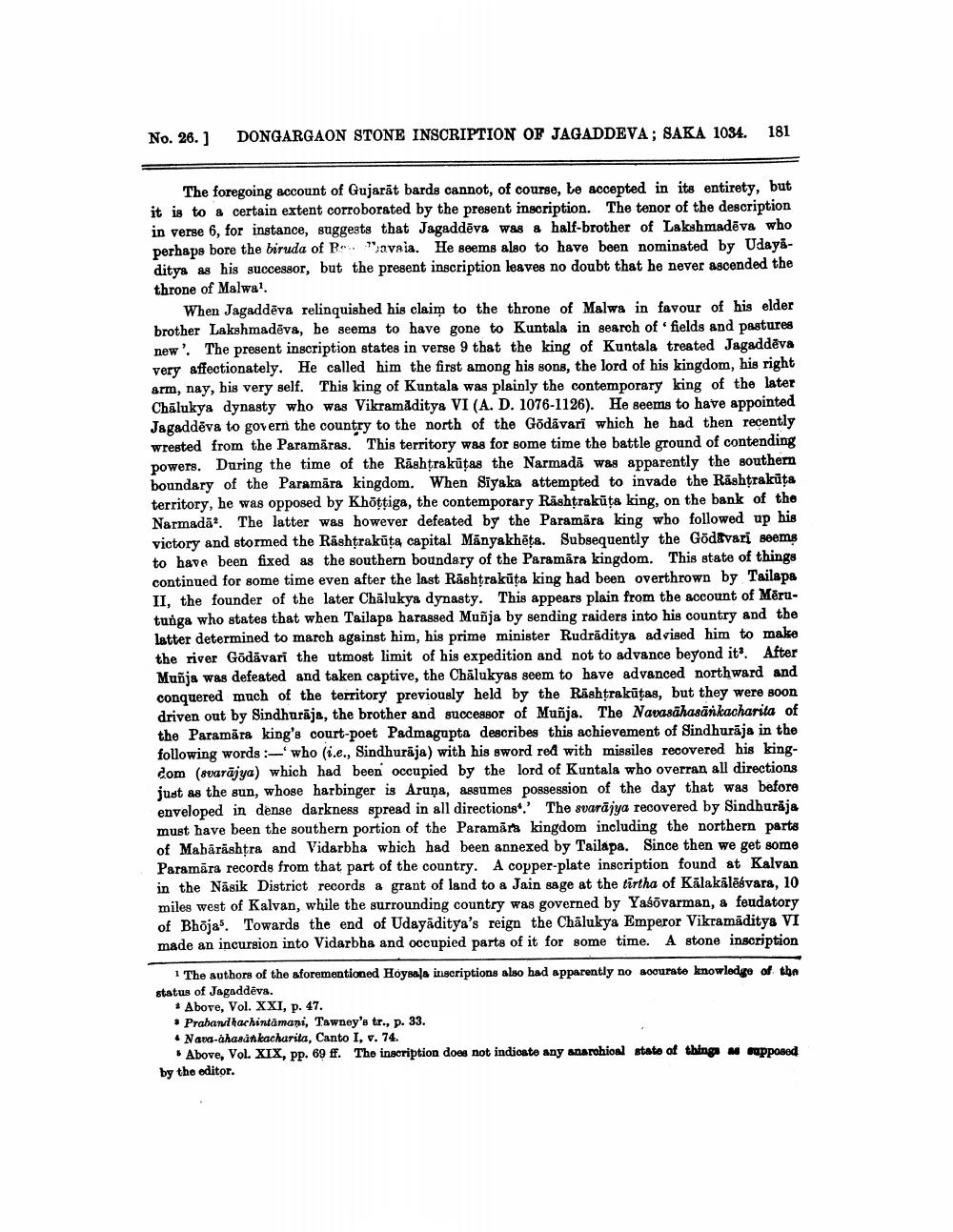________________
No. 26.]
DONGARGAON STONE INSCRIPTION OF JAGADDEVA; SAKA 1034.
181
The foregoing account of Gujarat bards cannot, of course, be accepted in its entirety, but it is to a certain extent corroborated by the present inscription. The tenor of the description in verse 6, for instance, suggests that Jagaddēva was a half-brother of Lakshmadēva who perhaps bore the biruda of P "avaia. He seems also to have been nominated by Udayaditya as his successor, but the present inscription leaves no doubt that he never ascended the throne of Malwa1.
When Jagaddēva relinquished his claim to the throne of Malwa in favour of his elder brother Lakshmadēva, he seems to have gone to Kuntala in search of fields and pastures new'. The present inscription states in verse 9 that the king of Kuntala treated Jagaddeva very affectionately. He called him the first among his sons, the lord of his kingdom, his right arm, nay, his very self. This king of Kuntala was plainly the contemporary king of the later Chalukya dynasty who was Vikramaditya VI (A. D. 1076-1126). He seems to have appointed Jagaddeva to govern the country to the north of the Godavari which he had then recently wrested from the Paramāras. This territory was for some time the battle ground of contending powers. During the time of the Rashtrakutas the Narmada was apparently the southern boundary of the Paramāra kingdom. When Siyaka attempted to invade the Rashtrakuta territory, he was opposed by Khōṭṭiga, the contemporary Rashtrakuta king, on the bank of the Narmada. The latter was however defeated by the Paramara king who followed up his victory and stormed the Rashtrakuta capital Manyakheta. Subsequently the Godavari seems to have been fixed as the southern boundary of the Paramāra kingdom. This state of things continued for some time even after the last Rashtrakuta king had been overthrown by Tailapa III, the founder of the later Chalukya dynasty. This appears plain from the account of Merutunga who states that when Tailapa harassed Muñja by sending raiders into his country and the latter determined to march against him, his prime minister Rudraditya advised him to make the river Godavari the utmost limit of his expedition and not to advance beyond it. After Muñja was defeated and taken captive, the Chalukyas seem to have advanced northward and conquered much of the territory previously held by the Rashtrakutas, but they were soon driven out by Sindhuraja, the brother and successor of Muñja. The Navasähasänkacharita of the Paramāra king's court-poet Padmagupta describes this achievement of Sindhurāja in the following words: who (i.e., Sindhuraja) with his sword red with missiles recovered his kingdom (svarajya) which had been occupied by the lord of Kuntala who overran all directions just as the sun, whose harbinger is Aruna, assumes possession of the day that was before enveloped in dense darkness spread in all directions.' The svarajya recovered by Sindhurāja must have been the southern portion of the Paramara kingdom including the northern parts of Maharashtra and Vidarbha which had been annexed by Tailapa. Since then we get some Paramāra records from that part of the country. A copper-plate inscription found at Kalvan in the Nasik District records a grant of land to a Jain sage at the tirtha of Kalakālē vara, 10 miles west of Kalvan, while the surrounding country was governed by Yasovarman, a feudatory of Bhoja. Towards the end of Udayaditya's reign the Chalukya Emperor Vikramaditya VI made an incursion into Vidarbha and occupied parts of it for some time. A stone inscription
1 The authors of the aforementioned Hoysala inscriptions also had apparently no accurate knowledge of the status of Jagaddēva.
* Above, Vol. XXI, p. 47.
• Prabandhachintamani, Tawney's tr., p. 33.
Nava-àhasankacharita, Canto I, v. 74.
Above, Vol. XIX, pp. 69 ff. The inscription does not indicate any anarchical state of things as supposed by the editor.




